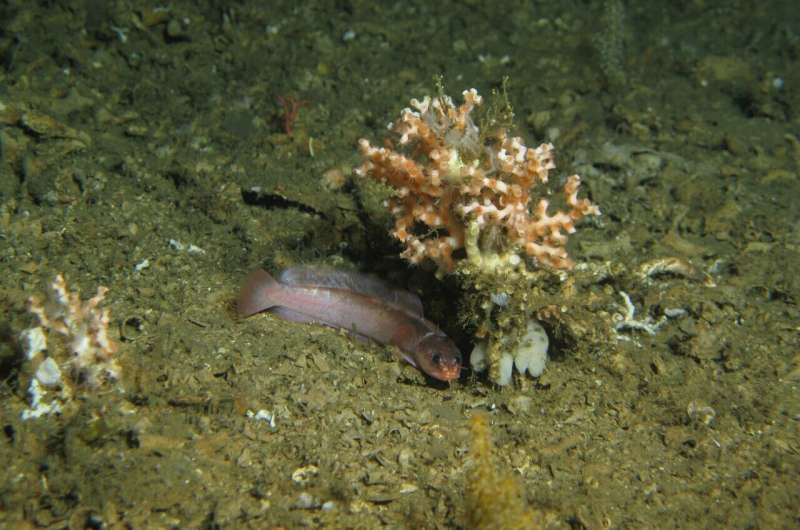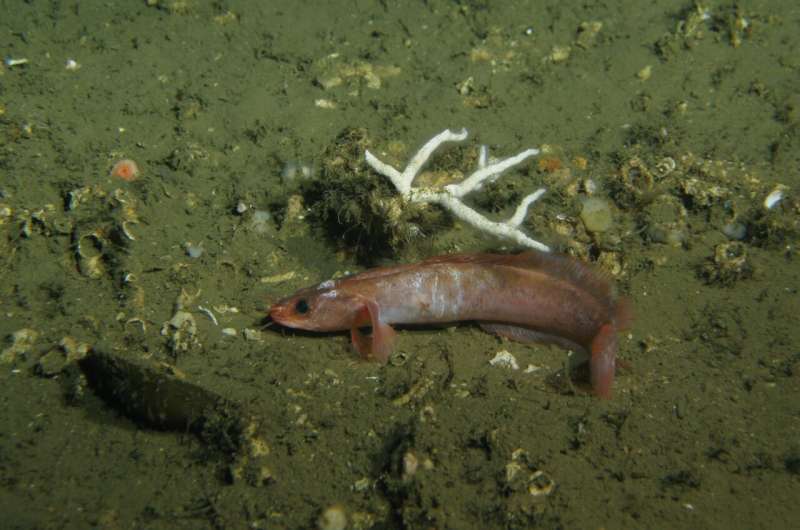This article has been reviewed according to Science X's editorial process and policies. Editors have highlighted the following attributes while ensuring the content's credibility:
fact-checked
peer-reviewed publication
trusted source
proofread
New fish species discovered in Mauritanian deep-water coral reefs

Together with a European team, researchers from Senckenberg am Meer in Wilhelmshaven have described a new fish species. Gaidropsarus mauritanicus is only about 73 millimeters long and lives in the deep-water coral reefs off the coast of Mauritania.
In their study, now published in the Journal of Fish Biology, the scientists explain that the fish from the rockling family probably remained undiscovered until now due to its small size and its protection-seeking behavior.
Over a quarter of the commercially caught marine fish worldwide belong to the cod family, including Atlantic cod, Alaska pollock, and haddock, which are of particular economic importance.
"However, the order Gadiformes also includes much smaller, mostly unknown and poorly studied fish families, such as the rocklings (Gaidropsaridae), which are of little commercial value but have a remarkably wide range," explains Alexander Knorrn from Senckenberg am Meer in Wilhelmshaven.
Together with Senckenberg researchers and colleagues from Portugal and Spain, Knorrn described a new species from the rockling family as part of his doctoral thesis. The fish, which is around 73 millimeters long and now serves as the holotype of the species, was observed for the first time and collected off the coast of Mauritania at a depth of 595 meters. This is the location of the world's largest deep-water coral reef complex, the "Mauritanian Wall," which extends for at least 580 kilometers, with a height between 80 and 100 meters.
"The fish species was also observed during eight remotely operated vehicle dives along the Mauritanian coast at depths between 613 and 416 meters," adds the researcher from Wilhelmshaven.

The new fish species could be distinguished from its congeners based on a combination of different characteristics—including the large eyes and the head, which takes up a quarter of the animal's body length, elongated ventral fins, and the pink coloration. Genetic analyses confirm that this is a previously undescribed species. "This is remarkable, as new vertebrate species are quite rare," says Knorrn.
The small fish was caught with the help of a grab, along with a variety of live deep-sea animals, including corals such as the framework-forming stony coral Desmophyllum pertusum or the red deep-water gorgonian Swiftia phaeton, as well as larger sponge colonies, bryozoans, brittle stars, annelids, decapod crustaceans, snails, and bivalves.
"Also the video footage shows that Gaidropsarus mauritanicus exclusively lives in the deep-water coral ecosystems," adds Knorrn. "One of the individuals we saw had whitish spots on its skin. It was the only fish we observed seeking shelter under a branched, whitish bryozoan, Celleporina cf. lucida."
The research team cites this presumed territoriality, coupled with a rather protection-seeking habit and the animals' small size, as the reason why the deep-sea species had remained undiscovered until now.
Coral reefs in the deep and cold regions of the world's oceans are of enormous importance as "nurseries," reproduction centers, and hunting grounds for predatory species. Many organisms such as fish, crabs, bivalves, sponges, and snails find shelter and food in their calcareous skeletons.
The reefs also serve as CO2 reservoirs. But deep-water corals are endangered: oxygen deficiency and ocean acidification are threatening the reefs. Intensive trawling also places considerable pressure on deep-sea corals.
"With the name Gaidropsarus mauritanicus, we would like to emphasize that Mauritania has a unique and enormously species-rich marine ecosystem in urgent need of protection," explains Prof. Dr. André Freiwald, Head of Marine Research at Senckenberg am Meer.
More information: Alexander H. Knorrn et al, Gaidropsarus mauritanicus (Gadiformes, Gaidropsaridae) a new three‐bearded rockling from a deep‐water coral ecosystem with a genetically verified biogeographical distribution of the genus and notes to its ecology and behavior, Journal of Fish Biology (2024). DOI: 10.1111/jfb.15859
Journal information: Journal of Fish Biology


















